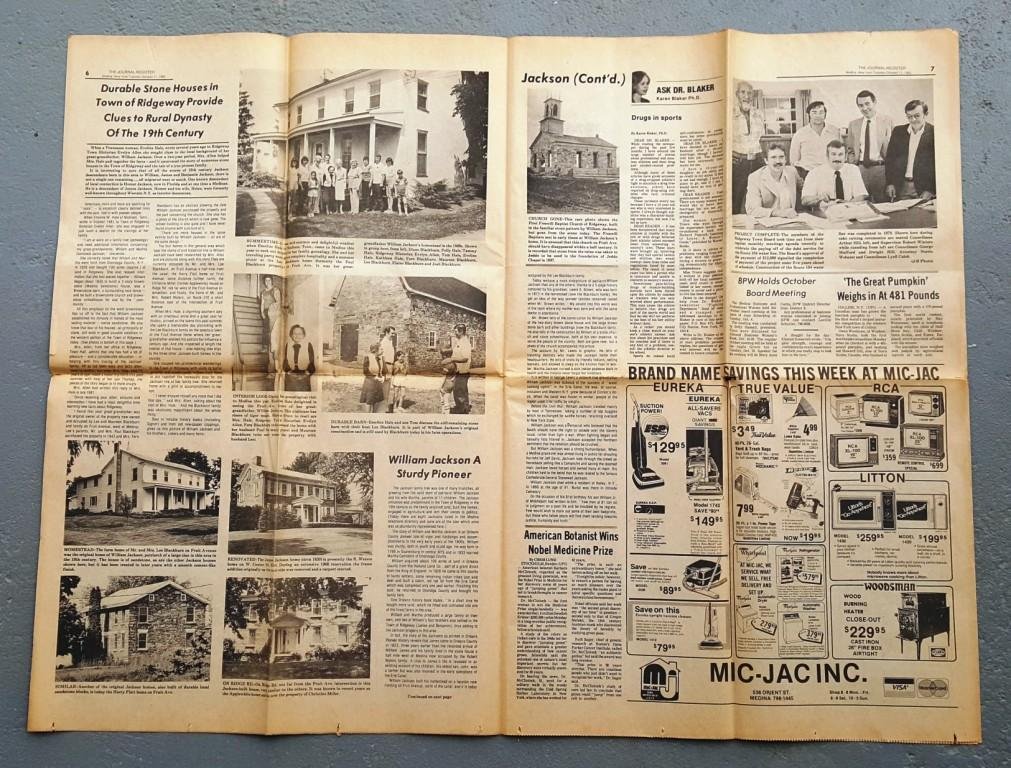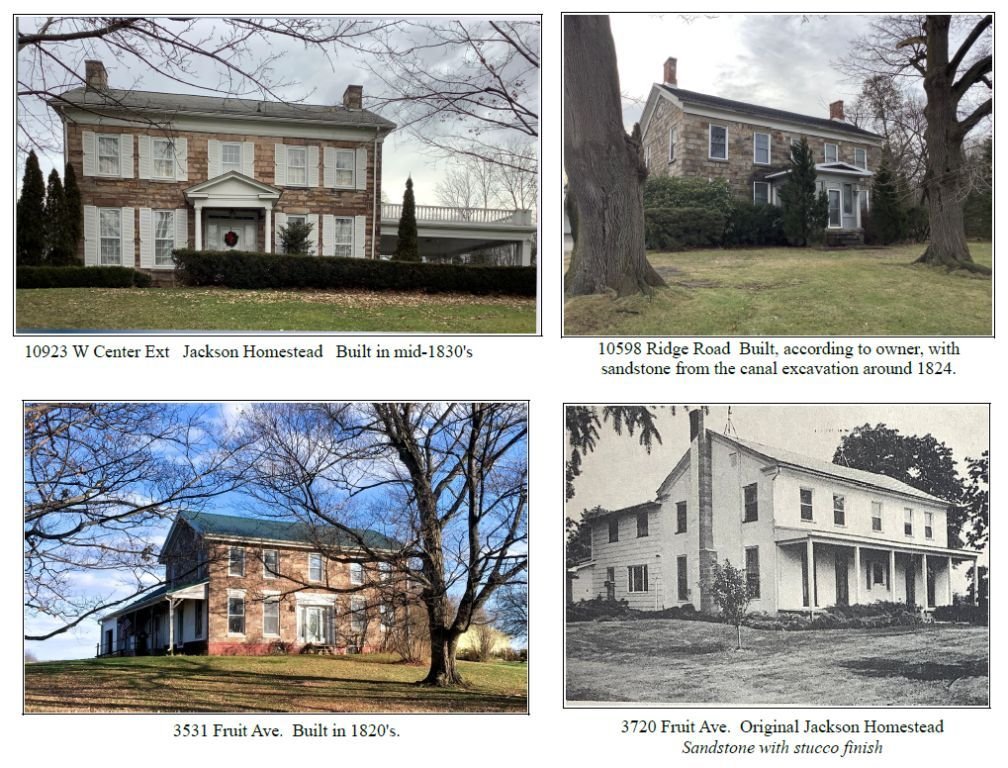Clues to Rural Dynasty Of The 19th Century
RIDGEWAY, NY (October 11, 1983) – When a Tennessee woman, Emeline Hale, wrote several years ago to Ridgeway Town Historian Evelyn Allen she sought clues to the local background of her great-grandfather, William Jackson. Over a two-year period, Mrs. Allen helped Mrs. Hale pull together the facts – and it uncovered the story of numerous stone houses in the Town of Ridgeway and the tale of a true pioneer family.
It is interesting to note that of all the scores of 19th century Jackson descendants born in this area to William, James, and Benjamin Jackson, there is not a single one remaining…all migrated west or south. One known descendant of local connection is Homer Jackson, now in Florida and at one time a Medinan. He is a descendant of James Jackson. Homer and his wife, Helen, were formerly well-known throughout Western N.Y. as interior decorators.
Americans more and more are searching for “roots” – to establish clearly defined links with the past, tied in with pioneer people.
When Emeline W. Hale of Madison, Tenn., wrote in October 1981 to Town of Ridgeway Historian Evelyn Allen, she was engaged in just such a search for the tracings of her family.
“I am at work on a family tree (genealogy) and need additional information concerning my great-grandparents, William and Martha Jackson,” she wrote.
She correctly noted that William and Martha went forth from Onondaga County, N.Y., in 1826 and bought 100 acres (approx.) of land in Ridgeway. She also relayed information that she had pieced together — William began about 1830 to build a 2-story brownstone (Medina sandstone) house, also a Brownstone barn, a surrounding rock fence — and he built a brownstone church and brownstone schoolhouse for use by the “community.”
All this emphasis on the word brownstone tips us off to the fact that William Jackson established his dynasty in homes of the most lasting material — native sandstone. We also know that four of his houses, all principally of stone, still exist in good useable condition in the western portion of the Town of Ridgeway today. (See photos at bottom of this page.)
Mrs. Allen from her office in Ridgeway Town Hall, admits that she has had a lot of pleasure — and a considerable education — in helping with this tracing of the Jackson family. All has not been easy, and facts often seem to conflict, but when Mrs. Hale, now 72 years of age, made a motor trip north this past summer with help of her son Thomas, the pieces of the story began to fit more snugly.
Mrs. Allen had written this reply to Mrs. Hale in late 1981:
“Since receiving your letter, pictures and information I have had a most delightful time learning new facts about Ridgeway.”
“I found that your great-grandfather was the original owner of the property now owned and occupied by Lee and Maureen Blackburn and family on Fruit Avenue, west of Medina. Lee’s parents, Mr. and Mrs. Paul Blackburn purchased the property in 1943 and Mrs. Fern Blackburn has an abstract showing the date William Jackson purchased the property and the part concerning the church. She also has a photo of the church which is now gone. The school building is also gone, and I never found anyone with a picture of it.”
“There are more houses in the same vicinity built by William Jackson — all are of the same design.”
The four homes in the general area which bear the stamp of and historical link to William Jackson have been researched by Mrs. Allen and are pictured along with this story. They are currently owned by Mr. and Mrs. Lee Blackburn, on Fruit Avenue a half-mile from the canal; the Harry Flatt home on Fruit Avenue, some distance further north; the Christine Miller (former Applewhite) house on Ridge Rd. not far west of the Fruit Avenue intersection, and finally, the home of Mr. and Mrs. Robert Waters, on Route 31E a short distance east of the intersection of Fruit Avenue.
When Mrs. Hale, a charming southern lady with an infectious smile and great zest for history, arrived on the scene this past summer she spent a memorable day picnicking with the Lee Blackburn family on the spacious lawn of the Fruit Avenue home where her great-grandfather wielded his patriarchal influence a century ago. And she inspected at length the interior of that house — also making side trips to the three other Jackson-built homes in the vicinity.
She coupled her architectural wanderings in the Town of Ridgeway with visits to burial grounds and county seats in New York State to put together the necessary data for the Jackson line of her family tree. She returned home with a glint of accomplishment in her eye.
“I never enjoyed myself any more than I did that day,” said Mrs. Allen, talking about the visit of Mrs. Hale. “And the Blackburn family was absolutely magnificent about the whole thing.”
Data in reliable history books (including Signor) and from old newspaper clippings, gives us this picture of William Jackson and his brothers, sisters, and many heirs.
William Jackson A Sturdy Pioneer
The Jackson family tree was one of many branches, all growing from a solid stem of patriarch William Jackson and his wife Martha, parents of 11 children. The Jackson influence was predominant in the Town of Ridgeway in the 19th century as the family acquired land, built fine homes, engaged in agriculture, and lent their voices to politics. (Today there are eight Jacksons listed in the Medina telephone directory and none are of the clan which once was so abundantly represented here.)
The story of William and Martha Jackson is an Orleans County pioneer tale of vigor and hardships and accomplishments in the very early years of the 1800s. William was sturdy, both in youth and in old age. He was born in 1799 in Duanesburg in Central NYS and in 1833 married Martha Comstock of Onondaga County.
William acquired about 100 acres of land in Orleans County from the Holland Land Co., part of a grant direct from the King of England. In 1826 he came to this county of hardy settlers, some remaining Indian tribes and wild deer and built a cabin, not too far from the Erie Canal which was completed only one year earlier. Finishing this task, he returned to Onondaga County and brought his family here.
On Orleans history book states, “In a short time he bought more land, which he fitted and cultivated into one of the finest farms in the area.”
William and Martha produced a large family of their own, and two of William’s four brothers also settled in the Town of Ridgeway (James and Benjamin), thus adding to the Jackson progeny in this area.
In fact, the story of the Jacksons as printed in the Orleans Pioneer History reveals that James came to Orleans County in 1823, three years earlier than the recorded arrival of William. James and his family lived in the stone house a half-mile west of Medina now occupied by the Robert Waters family. A clue to James’s life is revealed in an existing account of his children. His oldest son, John, was a farmer but was also involved in the early operations of the Erie Canal.
William Jackson built his homestead on a location now fronting on Fruit Avenue, north of the canal, and it is today occupied by the Lee Blackburn family.
Today we have a more vivid picture of patriarch William Jackson than any of the others, thanks to a 5-page history compiled by his grandson, Lewis E. Brown, who was born in 1873 in the homestead (now the Blackburn home). We get an idea of the way pioneer families remained rooted when Mr. Brown writes, “My advent into this world was in the room where my mother was born and with the same doctor in attendance.”
Mr. Brown tells of the construction by William Jackson of the two-story brown stone house and the large brown stone barn and other buildings (now the Blackburn farm). He also tells of the construction by William of a stone church and stone schoolhouse, both at his own expense, to serve the people of the vicinity. Both are gone now, but a photo of the church accompanies this article.
The account by Mr. Lewis is graphic. He tells of traveling dentists who made the Jackson home their headquarters. He tells of visits by friendly Indians, selling baskets, and allowed to sleep on the kitchen floor in winter. Martha nursed a sick Indian papoose back to health and the Indians never forgot her kindness.
It is written in George Lewis’s account that Grandfather William Jackson was dubious of the success of “water running uphill” in the Erie Canal. He was, of course, mistaken and Western N.Y. grew because of Clinton’s ditch. When the canal was frozen in winter, people of the region used it for traffic by sleighs.
Before the Civil War, William Jackson traveled mainly by boat to Tennessee, taking a number of top buggies which, he exchanged for saddle horses, returning overland to New York State.
William Jackson was a Democrat who believed that the South should have the right to secede over the slavery issue, rather than fight a war. When fighting began and casualty lists filtered in, Jackson accepted the Northern sentiment that the rebellion should be crushed.
But William Jackson was a strong humanitarian. When a Medina prankster was almost hung in public for shouting hurrahs for Jeff Davis, Jackson rode through the crowd on horseback yelling like a Comanche and saving the doomed man. Jackson loved horses and owned many of them. His children held to the belief that he was related to the famous Confederate General Stonewall Jackson.
William Jackson died while a resident of Holley, N.Y., in 1890 at the age of 91. Burial was there in Hillside Cemetery.
On the occasion of his 81st birthday his son William Jr. of Middleport had written to him, “Few men at 81 can sit in judgement on a past life and be troubled by no regrets. Few would wish to mark out some of their own footprints, but those who follow yours will find them tending towards justice, humanity, and truth.”
Newspaper Clipping from
The Journal Register on Tuesday, October 11, 1983
Medina, New York


Above are the homes that were built William Jackson.
Photographs courtesy of the Medina Sandstone Society.
www.sandstonesociety.org
Have a comment or a question, contact Mark Jackson at: mark.jackson@caldwelljournal.com
